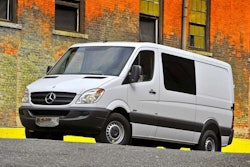BINDING TIES
Chain binders. Don’t let them make a fool out of you.
By Tom Jackson
(Photos by Bruce W. Smith)
It is true that a chain is only as strong as its weakest link.
And when you’re using chains as a backup safety device for trailers or to secure heavy equipment and cargo there are weak links aplenty to take note of.
At the top of the regulatory mountain are the Federal Department of Transportation rules 393.70 and 393.71.
But each state has some leeway to enforce their own towing and safety chain regulations, so checking with your state DOT is a must as well.
There are several websites where you can access these regs and we’ve listed them at the bottom of this article.
One of the more helpful resources we’ve come across regarding the use of chains is a document, available online from the U.S. Fish and Wildlife Service.
It’s that agency’s guide book for FWS employees and contractors on all kinds of heavy equipment operations and hauling.
The manual can be read or downloaded here: fws.gov/policy/243fw1.html. The specific chapter on chains is 243 FW 5: For towing, carrying cargo, and securing loads.
But there is lots of good advice not just on chains but other towing related issues as well. Here’s what it says:
- Couple every trailer, except fifth-wheel trailers, to the towing vehicle with safety chains or cables that meet Society of Automotive Engineers International standard J684. This prevents the vehicle and trailer from separating in case of a trailer or hitch disconnect.

- Cross safety chains or cables in an “X” pattern below the ball mount with enough slack so that they do not restrict turning, drag the ground, or allow the coupler to hit the ground.
- Use properly rated safety chains with clevis hooks that have a functioning safety latch to prevent the hook from disconnecting from the tow vehicle except for when a trailer manufacturer that provides “S” style chain hooks as OEM equipment.
- Do not twist the safety chains to shorten their length.
- Determine the size of the chain to use by the weight of the equipment that you are transporting and the Working Load Limit (WLL) of the chain and other tiedown components. The size/grade/strength of all tiedown components must, at a minimum, meet the requirements in section 5.8B and 49 CFR 393. WLL is the maximum safe load that may be applied to a component of a cargo securement system during normal service.
- The Aggregate WLL (AWLL) is the sum of the WLLs of all the tiedowns of any securement system and must be equal to or greater than 50 percent of the weight of the cargo. You may add tiedown WLLs together to determine the AWLL. The formula for determining the AWLL depends on the method of the tiedown system you use (see 49 CFR 393.106(d)). If a State DOT program requires the aggregate WLL to equal more than 50 percent of the weight of the article you are transporting, you must follow the State requirement.
- Use 50 percent of the WLL of each tiedown assembly to calculate the AWLL if the tiedown goes from an anchor point on the transport vehicle to an attachment point on the cargo, or it attaches to the transport vehicle, goes over, through, or around the cargo and attaches to the same side of the transport vehicle.
- Use 100 percent of the WLL of each tiedown assembly to calculate the AWLL if the tiedown goes from one side of the transport vehicle, over, through, or around the cargo and attaches to the opposite side of the transport vehicle.

- Use a minimum of four separate tiedowns for heavy and light duty equipment and additional tiedowns for attachments/implements as required in 49 CFR 393.110 and 393.130 (also see section 5.10).
- Place tiedowns so that the equipment/cargo does not move forward, backward, or from side to side. DOT requires a tiedown assembly every 10 feet (3 meters) of the equipment/cargo length.
- Use chain assemblies for tiedowns in accordance with 49 CFR 393.100-136.
- Do not use cold shuts (devices to join links of a chain) to extend the working length of a chain or as a component of any tiedown assembly. You may only add devices that are approved by the chain manufacturer and that maintain the integrity and rating of the tiedown assembly.
- When you use tiedown chains, only use ratchet load binders. You may not use lever type load binders.
- Use edge protection where chains or straps contact equipment edges and those edges may damage securement devices (cause abrasion or cutting).
More About Safety Chains & Binders
State safety chain laws can be found at the following websites:
webspace.webring.com/people/jv/vintage_campers1/StateSafetyChainLaws.pdf
State by state towing regs:
www.towingworld.com/articles/TowingLaws.htm
Federal DOT laws regarding chains and safety devices:
www.fmcsa.dot.gov/rules-regulations/administration/fmcsr/fmcsrruletext.aspx?reg=393.70









